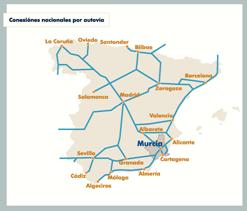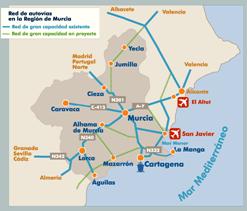8th International Conference on Middle English
|
| Main Page | Venue | Organization & Scientific Committee | CFP | Registration | Accommodation & Social Events | Plenary Speakers | Programme | List of Papers | |
VENUE |
8th International Conference on Middle English
|
| Main Page | Venue | Organization & Scientific Committee | CFP | Registration | Accommodation & Social Events | Plenary Speakers | Programme | List of Papers | |
VENUE |
8th International Conference on Middle English ICOME-8 2-4 May 2013, University of Murcia |
ICOME 8 will be held in the premises of Campus La Merced, located in the heart of the thriving town centre of Murcia. The Campus borders the old quarter, near the Cathedral, and features one of the main historical buildings in the town: the old cloister, a former religious building. The history of the University of Murcia can trace its roots back to the 13th century and the reign of King Alfonso X the Wise, and it was last re-founded in 1915.
It hosts more than 31.000 students, around 1.000 of them international, and offers 51 undergraduate programs, 53 doctoral ones and funds around 327 research groups. The variety of academic offer, the possibility of studying Spanish as a second language, our strategic location, Murcia bustling atmosphere, as well as our mild weather all year round make the University of Murcia an attractive destination for students, professors and researches from all over the world. The conference will be held in the Facultad de Letras and the Aulario de La Merced of the University of Murcia, located on the city centre university campus (Campus de La Merced).
The Aulario de La Merced is a lecture building with 35 seminar rooms and a lecture theatre called Aula Antonio Soler (150 people), and the Paraninfo is an auditorium which is able to host 450 people for plenary sessions. The Faculty has 2 seminar rooms available (45 people each) and a lecture theatre for 190 people called Hemiciclo.
Murcia is the capital city of the namesake Region. It was established in AD 825 and stands out for its collection of baroque sculptures and buildings.
MurciaCity is the capital of the Region with about 450,000 inhabitants; it is a university city that is also monumental and artistic, enabling you to find architectural jewels of great beauty. At the same time it is a modern city with great contemporary creativity: exhibitions, theatre, music, opera, dance, etc. There is a first class gastronomic culture. The excellent produce of the huerta, a varied offer of meats and the prized treasures of the sea ..., a cuisine assimilating the products bequeathed by the peoples who settled here for centuries. Murcia provides a good example of Spanish tapas culture and has a wide range of culinary specialities to offer.
The Region of Murcia enjoys excellent links with the rest of Spain through a full communications network (by land, sea and air). There are two airports that connect Murcia by air directly with Europe: Murcia Airport (San Javier) and Alicante Airport (El Altet). San Javier Airport is located on the northern shore of Mar Menor, at a distance of 47 kms from the city of Murcia by dual carriageway. This airport will shortly be replaced with a new one called Corvera, 20 kms from Murcia. Alicante (El Altet) Airport is 68 kms from Murcia (45 minutes away by motorway).
The Region of Murcia is also linked to the rest of Spain by a full road network. Albacete and Madrid can be reached via the A30 motorway. The connection with the Mediterranean seaboard through Alicante and Valencia can be made by an inland route using the E15 motorway, or by the N-332 trunk road which follows the coast starting from Cartagena. To the south it is connected to Andalusia by the A92 and E15 motorways, leading to Granada and Almería respectively.  
Click here to know more about the Region of Murcia:
|
|
|
|
Webmaster Nila Vázquez
Last Update:
24/04/13